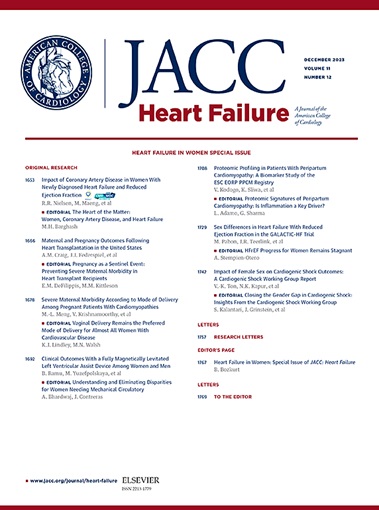肺动脉高压及相关心力衰竭的全球负担:2021 年全球疾病负担分析》。
IF 11.8
1区 医学
Q1 CARDIAC & CARDIOVASCULAR SYSTEMS
引用次数: 0
摘要
背景:肺动脉高压(PAH)和相关的心力衰竭(HF)是新兴的全球健康挑战。目的:本研究旨在分析1990年至2021年全球、区域和国家多环芳烃和多环芳烃相关HF的负担,使用2021年全球疾病负担(GBD)估计值,观察时间趋势,并预测到2050年的未来模式。方法:患病率、发病率、残疾调整生命年(DALYs)和死亡数据来自GBD 2021。趋势变化分析采用联结点回归,年龄结构、人口增长和流行病学变化量化采用分解分析,预测采用贝叶斯年龄-时期-队列模型。结果:2021年,全球多环芳烃患病率为2.28 / 10万,较1990年略有下降(平均年变化率[AAPC]: -0.03;95% CI: -0.05 ~ -0.01),发病率上升至0.52 / 10万(AAPC: 0.10;95% ci: 0.10-0.11)。DALYs降至8.24 / 10万(AAPC: -1.52;95% CI: -1.64至-1.40),死亡率降至0.27 / 10万(AAPC: -0.82;95% CI: -0.95 ~ -0.68)。多环芳烃导致的衰老和生长死亡增加。女性的多环芳烃患病率和发病率较高,到2021年,女性的DALYs和死亡率超过了男性。对于多环芳烃相关的心衰,患病率上升到191808例,残疾生活年限从9788年上升到17765年,尽管发病率有所下降。预计这些趋势将持续到2050年,病例和死亡人数将上升,但从2019年到2021年,发病率将保持稳定。结论:尽管年龄标准化率有所下降,但由于老龄化和人口增长,多环芳烃的负担仍然存在。未来的干预措施应解决多环芳烃的地区和性别差异。本文章由计算机程序翻译,如有差异,请以英文原文为准。
Global Burden of Pulmonary Arterial Hypertension and Associated Heart Failure
Background
Pulmonary arterial hypertension (PAH) and associated heart failure (HF) are emerging global health challenges.
Objectives
This study aimed to analyze the global, regional, and national burden of PAH and PAH-related HF from 1990 to 2021 with the use of GBD (Global Burden of Disease) 2021 estimates, to observe temporal trends, and to predict future patterns through 2050.
Methods
Data on prevalence, incidence, disability-adjusted life years (DALYs), and deaths were derived from GBD 2021. Joinpoint regression was adopted for analyzing trends and changes, decomposition analysis for quantifying impacts of age structure, population growth, and epidemiologic changes, and the Bayesian age-period-cohort model for predictions.
Results
In 2021, global PAH prevalence was 2.28 per 100,000, slightly down from 1990 (average annual percent change [AAPC]: −0.03; 95% CI: −0.05 to −0.01), and incidence rose to 0.52 per 100,000 (AAPC: 0.10; 95% CI: 0.10-0.11). DALYs fell to 8.24 per 100,000 (AAPC: −1.52; 95% CI: −1.64 to −1.40), and deaths dropped to 0.27 per 100,000 (AAPC: −0.82; 95% CI: −0.95 to −0.68). Increased PAH deaths from aging and growth. Women had higher PAH prevalence and incidence, and by 2021 surpassed men in DALYs and deaths rates. For PAH-related HF, prevalence rose to 191,808 cases and years lived with disability rose from 9,788 to 17,765, although rates declined. These trends are projected to persist through 2050, with cases and deaths rising but rates stable from 2019 to 2021.
Conclusions
The burden of PAH persists due to aging and population growth, despite declining age-standardized rates. Future interventions should address regional and sex disparities in PAH.
求助全文
通过发布文献求助,成功后即可免费获取论文全文。
去求助
来源期刊

JACC. Heart failure
CARDIAC & CARDIOVASCULAR SYSTEMS-
CiteScore
21.20
自引率
2.30%
发文量
164
期刊介绍:
JACC: Heart Failure publishes crucial findings on the pathophysiology, diagnosis, treatment, and care of heart failure patients. The goal is to enhance understanding through timely scientific communication on disease, clinical trials, outcomes, and therapeutic advances. The Journal fosters interdisciplinary connections with neuroscience, pulmonary medicine, nephrology, electrophysiology, and surgery related to heart failure. It also covers articles on pharmacogenetics, biomarkers, and metabolomics.
 求助内容:
求助内容: 应助结果提醒方式:
应助结果提醒方式:


